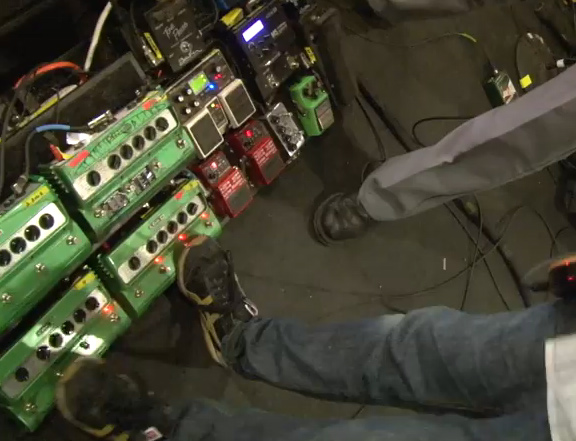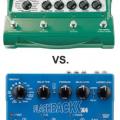 The following is a guest post by Jake Van Paepeghem. If you are interested in guest posting, please contact me!
The following is a guest post by Jake Van Paepeghem. If you are interested in guest posting, please contact me!
Just like any subgroup in any culture, being a guitar player comes with its own set of idiosyncrasies.
Every instrument has them in my experience. For singers it can be the, “I would have sounded much better if I wasn’t so sick today”, or with drummers it’s usually, “I couldn’t hear a THING out there!” It’s the thick rimmed vintage glasses of the hipster, or the ornately studded t-shirt and cauliflower ear of the UFC fan. And for a large portion of guitar players, the delay pedal is the basic white girl’s pumpkin spice latte.
Now, I cannot in good conscience continue without disclosing that I too have been known to subscribe to these cliché’s just as much as the next Bonnaroo/Brock Lesnar/Starbucks enthusiast. Especially when it comes to the safety net of a good delay pedal.
Until a few years ago a good delay was, for me, the sprinkles on the cupcake. The cherry on top. It was present to enhance short guitar parts, or, to provide ambient swells while the stage lights switch to dark blues and greens and the front man starts a ballad (a la, “The Warmth” by Incubus). But slowly, through the tinkering of the player brain and the inevitability of becoming a gear head, the delay started to take over every thought I had about my guitar playing.
It all started with the Boss RV-3; reverb and delay, no tap tempo, and digital delay combined with reverb. I remember manually setting the tempos by marking the actual time knob with dots of white out. It added just the amount of taste we were searching for. Then I moved to the Boss DD-6; same idea, but with an available tap tempo, a fun reverse, and a few other tricks. I got to experimenting with infinite feedback loops and general noise making. But once I hit the Line 6 DL4, there was no looking back. I always had a delay on. For every song. At every gig.
Once it was time for an upgrade I added the TC Electronic Flashback X4, before soon moving into building and creating my own analog delays and adding mods to my existing pedals. Pretty soon I had so many tweaked presets, and so many different pedals that all did the same thing, that I hadn’t actually written anything beyond a demo riff in over a year. Because for all that time all I was doing was tweaking parameters and playing ambient stuff just to hear it echo (echo, echo, echo, echo…)
It wasn’t until one particular afternoon rehearsal, having taken a different car, that I arrived without my trusty 9/12-volt companions and had to play “sans-pedal board” for the first time since my delay awakening. That day I was forced to play a normal, unaltered tone, on songs that had been written specifically with delay as their cornerstone. It was a fascinating experiment on my own fortitude.
When you have a pedal on your board with multiple presets (DL4, Flashback, TimeLine, etc), it’s easy to simply keep one on all the time. It lays a bed for the guitar providing a sort of safety net. It can make one guitar sound like five, turning a single tenor voice into a full men’s section, or one big dude in to an entire offensive line. But when I suddenly didn’t have the option of making my guitar more than* my* guitar, I had to seriously talk myself down from the ledge. When I pulled my left hand off the neck, the guitar stopped making sound. When I plucked an arpeggio, I only heard the notes I was playing directly. Try sitting down at the piano, and having no sustain pedal; the sound stops when you lift your hands!
Though this was scary at first, aggravating and uncomfortable, I forced myself to adjust for that rehearsal. I decided I wasn’t going to say the guitarist version of the phrases given earlier, “Sorry guys, this will sound better later when I have all my gear”. I approached my playing from the standpoint of the strings. Not the pickups, not the cables, not the pedals, not the amp. The tone started and finished with my fingertips, and beyond that there was no adjustment to be made, no knobs to be turned.
The fascinating part is that once I got past the initial uncomfortableness I was led to reinterpretations of the songs; not only different guitar parts but subsequently different keyboard parts, different bass lines, and different versions of the songs entirely. Some which even made their way into the set regularly. The previously running joke in my band (Interstate) was that when we took songs out from the writing room, as our keyboard player put it, “Jake will just add delay and it becomes an Interstate song”. Well, not so much anymore!
Now, I don’t mean to dichotomize guitar players by suggesting you must pick which tribe you want to belong. I still use a TON of delay, and I realize how it may look, me telling a story advocating not using pedals on a site specifically dedicated to pedals. But the takeaway I am hoping for is the idea that as a guitar player, a songwriter, a producer, UFC fighter, basic white girl, or whatever it is you identify with at any given time, finding your crutches (however big or small) and getting yourself out of your comfort zone, can lead to some inspiring “ah-ha” moments. If you sit down at your rig and the first thing you do is click on your distortion or your reverb or whatever you think makes your sound your sound, spend a day instead with that pedal still in its case. Go a day without your compressor, your pumpkin spice, or maybe wear your contacts and an appropriately fitting, non-ripped, modern sweater. I mean, even Lady Gaga has to take the flank steaks off her shoulders at some point, right?
-Jake Van Paepeghem
Jake Van Paepeghem, a northwest native, is a guitarist, songwriter and producer. Having toured with American Idol winner Kris Allen, Fueled By Ramen artist This Providence, as well as many sessions and live performances with jazz artists like Emily Braden and John Proulx, Jake writes with his longtime band Interstate, where he resides with his collie mix Sara in Boise Idaho.
Interstateband.net



Leave a Reply